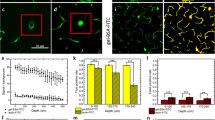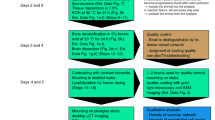Abstract
We introduce a novel protocol to stain, visualize, and analyze blood vessels from the rat and mouse cerebrum. This technique utilizes the fluorescent dye, DiI, to label the lumen of the vasculature followed by perfusion fixation. Following brain extraction, the labeled vasculature is then imaged using wide-field fluorescence microscopy for axial and coronal images and can be followed by regional confocal microscopy. Axial and coronal images can be analyzed using classical angiographic methods for vessel density, length, and other features. We also have developed a novel fractal analysis to assess vascular complexity. Our protocol has been optimized for adult rat, adult mouse, and neonatal mouse studies. The protocol is efficient, can be rapidly completed, stains cerebral vessels with a bright fluorescence, and provides valuable quantitative data. This method has a broad range of applications, and we demonstrate its use to study the vasculature in assorted models of acquired brain injury.






Similar content being viewed by others
References
Cipolla MJ. The cerebral circulation. integrated systems physiology: from molecule to function. San Rafael (CA) 2009.
Xing C, Arai K, Lo EH, Hommel M. Pathophysiologic cascades in ischemic stroke. Int J Stroke. 2012;7(5):378–85. https://doi.org/10.1111/j.1747-4949.2012.00839.x.
Taoufik E, Probert L. Ischemic neuronal damage. Curr Pharm Des. 2008;14(33):3565–73.
Muoio V, Persson PB, Sendeski MM. The neurovascular unit—concept review. Acta Physiol (Oxf). 2014;210(4):790–8. https://doi.org/10.1111/apha.12250.
Cauli B, Hamel E. Revisiting the role of neurons in neurovascular coupling. Front Neuroenerg. 2010;2:9. https://doi.org/10.3389/fnene.2010.00009.
Hughes S, Dashkin O, Defazio RA. Vessel painting technique for visualizing the cerebral vascular architecture of the mouse. Methods Mol Biol. 2014;1135:127–38. https://doi.org/10.1007/978-1-4939-0320-7_12.
Li Y, Song Y, Zhao L, Gaidosh G, Laties AM, Wen R. Direct labeling and visualization of blood vessels with lipophilic carbocyanine dye DiI. Nat Protoc. 2008;3(11):1703–8. https://doi.org/10.1038/nprot.2008.172.
Moy AJ, Wiersma MP, Choi B. Optical histology: a method to visualize microvasculature in thick tissue sections of mouse brain. PLoS One. 2013;8(1):e53753. https://doi.org/10.1371/journal.pone.0053753.
Salehi A, Jullienne A, Baghchechi M, Hamer M, Walsworth M, Donovan V et al. Up-regulation of Wnt/β-catenin expression is accompanied with vascular repair after traumatic brain injury. J Cereb Blood Flow Metab 2018;38(2):274–89. https://doi.org/10.1177/0271678X17744124.
Joshi VS, Reinhardt JM, Garvin MK, Abramoff MD. Automated method for identification and artery-venous classification of vessel trees in retinal vessel networks. PLoS One. 2014;9(2):e88061. https://doi.org/10.1371/journal.pone.0088061.
Bell RD, Winkler EA, Singh I, Sagare AP, Deane R, Wu Z, et al. Apolipoprotein E controls cerebrovascular integrity via cyclophilin A. Nature. 2012;485(7399):512–6. https://doi.org/10.1038/nature11087.
Zudaire E, Gambardella L, Kurcz C, Vermeren S. A computational tool for quantitative analysis of vascular networks. PLoS One. 2011;6(11):e27385. https://doi.org/10.1371/journal.pone.0027385.
Di Ieva A, Grizzi F, Jelinek H, Pellionisz AJ, Losa GA. Fractals in the neurosciences, part I: general principles and basic neurosciences. Neuroscientist. 2014;20(4):403–17. https://doi.org/10.1177/1073858413513927.
Di Ieva A, Esteban FJ, Grizzi F, Klonowski W, Martin-Landrove M. Fractals in the neurosciences, part II: clinical applications and future perspectives. Neuroscientist. 2015;21(1):30–43. https://doi.org/10.1177/1073858413513928.
Karperien A, Ahammer H, Jelinek HF. Quantitating the subtleties of microglial morphology with fractal analysis. Front Cell Neurosci. 2013;7:3. https://doi.org/10.3389/fncel.2013.00003.
Borodinsky LN, Fiszman ML. A single-cell model to study changes in neuronal fractal dimension. Methods. 2001;24(4):341–5. https://doi.org/10.1006/meth.2001.1204.
Caserta F, Eldred WD, Fernandez E, Hausman RE, Stanford LR, Bulderev SV, et al. Determination of fractal dimension of physiologically characterized neurons in two and three dimensions. J Neurosci Methods. 1995;56(2):133–44.
Gadde SG, Anegondi N, Bhanushali D, Chidambara L, Yadav NK, Khurana A, et al. Quantification of vessel density in retinal optical coherence tomography angiography images using local fractal dimension. Invest Ophthalmol Vis Sci. 2016;57(1):246–52. https://doi.org/10.1167/iovs.15-18287.
Di Ieva A, Grizzi F, Sherif C, Matula C, Tschabitscher M. Angioarchitectural heterogeneity in human glioblastoma multiforme: a fractal-based histopathological assessment. Microvasc Res. 2011;81(2):222–30. https://doi.org/10.1016/j.mvr.2010.12.006.
Obenaus A, Ng M, Orantes AM, Kinney-Lang E, Rashid F, Hamer M, et al. Traumatic brain injury results in acute rarefication of the vascular network. Sci Rep. 2017;7(1):239. https://doi.org/10.1038/s41598-017-00161-4.
Honig MG, Hume RI. Dil and diO: versatile fluorescent dyes for neuronal labelling and pathway tracing. Trends Neurosci. 1989;12(9):333–5. 40-1
Konno A, Matsumoto N, Okazaki S. Improved vessel painting with carbocyanine dye-liposome solution for visualisation of vasculature. Sci Rep. 2017;7(1):10089. https://doi.org/10.1038/s41598-017-09496-4.
Okyere B, Giridhar K, Hazy A, Chen M, Keimig D, Bielitz RC, et al. Endothelial-specific EphA4 negatively regulates native pial collateral formation and re-perfusion following hindlimb ischemia. PLoS One. 2016;11(7):e0159930. https://doi.org/10.1371/journal.pone.0159930.
Schindelin J, Arganda-Carreras I, Frise E, Kaynig V, Longair M, Pietzsch T, et al. Fiji: an open-source platform for biological-image analysis. Nat Methods. 2012;9(7):676–82. https://doi.org/10.1038/nmeth.2019.
Okyere B, Creasey M, Lebovitz Y, Theus MH. Temporal remodeling of pial collaterals and functional deficits in a murine model of ischemic stroke. J Neurosci Methods. 2017;293:86–96. https://doi.org/10.1016/j.jneumeth.2017.09.010.
Jullienne A, Salehi A, Affeldt B, Baghchechi M, Haddad E, Avitua A et al. Male and female mice exhibit divergent responses of the cortical vasculature to traumatic brain injury. J Neurotrauma. 2018. https://doi.org/10.1089/neu.2017.5547.
Harb R, Whiteus C, Freitas C, Grutzendler J. In vivo imaging of cerebral microvascular plasticity from birth to death. J Cereb Blood Flow Metab. 2013;33(1):146–56. https://doi.org/10.1038/jcbfm.2012.152.
Kienast Y, von Baumgarten L, Fuhrmann M, Klinkert WE, Goldbrunner R, Herms J, et al. Real-time imaging reveals the single steps of brain metastasis formation. Nat Med. 2010;16(1):116–22. https://doi.org/10.1038/nm.2072.
Fumagalli S, Ortolano F, De Simoni MG. A close look at brain dynamics: cells and vessels seen by in vivo two-photon microscopy. Prog Neurobiol. 2014;121:36–54. https://doi.org/10.1016/j.pneurobio.2014.06.005.
Shen Q, Huang S, Duong TQ. Ultra-high spatial resolution basal and evoked cerebral blood flow MRI of the rat brain. Brain Res. 2015;1599:126–36. https://doi.org/10.1016/j.brainres.2014.12.049.
Ostergaard L, Engedal TS, Aamand R, Mikkelsen R, Iversen NK, Anzabi M, et al. Capillary transit time heterogeneity and flow-metabolism coupling after traumatic brain injury. J Cereb Blood Flow Metab. 2014;34(10):1585–98. https://doi.org/10.1038/jcbfm.2014.131.
Sato Y, Nakajima S, Shiraga N, Atsumi H, Yoshida S, Koller T, et al. Three-dimensional multi-scale line filter for segmentation and visualization of curvilinear structures in medical images. Med Image Anal. 1998;2(2):143–68.
Zeller K, Vogel J, Kuschinsky W. Postnatal distribution of Glut1 glucose transporter and relative capillary density in blood-brain barrier structures and circumventricular organs during development. Brain Res Dev Brain Res. 1996;91(2):200–8.
Wang DB, Blocher NC, Spence ME, Rovainen CM, Woolsey TA. Development and remodeling of cerebral blood vessels and their flow in postnatal mice observed with in vivo videomicroscopy. J Cereb Blood Flow Metab. 1992;12(6):935–46. https://doi.org/10.1038/jcbfm.1992.130.
Krafft PR, Rolland WB, Duris K, Lekic T, Campbell A, Tang J, et al. Modeling intracerebral hemorrhage in mice: injection of autologous blood or bacterial collagenase. J Vis Exp. 2012;67:e4289. https://doi.org/10.3791/4289.
Suzuki H, Ayer R, Sugawara T, Chen W, Sozen T, Hasegawa Y, et al. Protective effects of recombinant osteopontin on early brain injury after subarachnoid hemorrhage in rats. Crit Care Med. 2010;38(2):612–8. https://doi.org/10.1097/CCM.0b013e3181c027ae.
Mu J, Ostrowski RP, Krafft PR, Tang J, Zhang JH. Serum leptin levels decrease after permanent MCAo in the rat and remain unaffected by delayed hyperbaric oxygen therapy. Med Gas Res. 2013;3(1):8. https://doi.org/10.1186/2045-9912-3-8.
Hama H, Hioki H, Namiki K, Hoshida T, Kurokawa H, Ishidate F, et al. ScaleS: an optical clearing palette for biological imaging. Nat Neurosci. 2015;18(10):1518–29. https://doi.org/10.1038/nn.4107.
Richardson DS, Lichtman JW. Clarifying tissue clearing. Cell. 2015;162(2):246–57. https://doi.org/10.1016/j.cell.2015.06.067.
Zhang Lin-Yuan, Lin Pan, Pan Jiaji, Ma Y, Wei Zhenyu, Jiang Lu et al. CLARITY for high-resolution imaging and quantification of vasculature in the whole mouse brain. Aging and Disease 2018;9(1). doi: 10.14336/ad.2017.0613.
Hama H, Kurokawa H, Kawano H, Ando R, Shimogori T, Noda H, et al. Scale: a chemical approach for fluorescence imaging and reconstruction of transparent mouse brain. Nat Neurosci. 2011;14(11):1481–8. https://doi.org/10.1038/nn.2928.
Acknowledgements
We would like to thank Monica Romero for her assistance with the confocal imaging which was performed in the LLUSM Advanced Imaging and Microscopy Core with support of NSF Grant MRI-DBI 0923559 and the Loma Linda University School of Medicine.
Funding
This study was supported by an NIH Program Project grant from the National Institute of Neurological Disorders and Stroke (1P01NS082184, Project 3).
Author information
Authors and Affiliations
Contributions
AS, AJ, KW, MH, and AO contributed to the conception and design of the study. AS, AJ, KW, and MH acquired and analyzed the data. AS, AJ, and AO drafted a significant portion of the manuscript and figures. AO, JT, JZ, WP, RD, and ZV edited the final draft. All authors read and approved the final manuscript.
Corresponding author
Ethics declarations
Conflict of Interest
The authors declare that they have no conflict of interest.
Research Involving Animals
All procedures performed in studies involving animals were in accordance with the ethical standards of Loma Linda University Animal Health and Safety Committee (according to the Guide For the Care and Use of Laboratory Animals, Eighth edition) at which the studies were conducted.
Resource Sharing
We will provide published data and relevant protocols upon request. Unpublished information can be made available by providing a request to the Principal Investigator by phone call or email.
Electronic Supplementary Material
ESM 1
(DOCX 6.81 MB)
Rights and permissions
About this article
Cite this article
Salehi, A., Jullienne, A., Wendel, K.M. et al. A Novel Technique for Visualizing and Analyzing the Cerebral Vasculature in Rodents. Transl. Stroke Res. 10, 216–230 (2019). https://doi.org/10.1007/s12975-018-0632-0
Received:
Revised:
Accepted:
Published:
Issue Date:
DOI: https://doi.org/10.1007/s12975-018-0632-0




